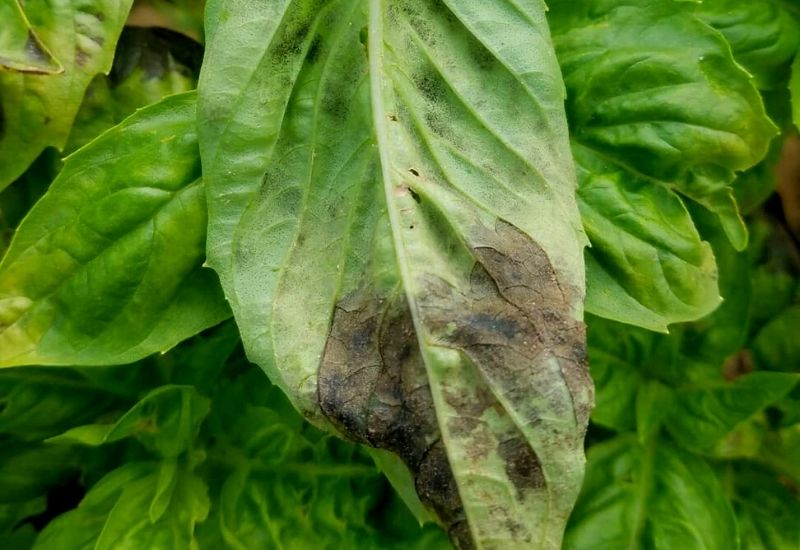Basil is one of the most commonly grown herbs in home gardens. Its aromatic leaves add flavor to many dishes. However, nothing is more frustrating than seeing unsightly black marks appear on the leaves of your prized basil plants. These marks not only detract from the plant’s appearance but can also impact its health and vigor.
In this comprehensive guide, we will explore the various causes of black marks on basil leaves and provide effective solutions to treat and prevent this problem.
What Causes Black Marks on Basil Leaves?
There are several potential culprits that can lead to the development of black marks on basil foliage
Fungal Diseases
Fungal pathogens like downy mildew are common causes of black spotting on basil. Initial symptoms include yellowing on leaf surfaces which develops into black or brown necrotic lesions Downy mildew thrives in cool, wet conditions
Other fungal diseases like gray mold, leaf spot, and botrytis blight can also cause black marks on basil leaves. High humidity encourages these fungal infections.
Bacterial Infections
Bacterial leaf spot, caused by the bacterium Pseudomonas cichorii, infects basil mainly during warm, rainy weather. Small dark spots that expand into large black marks signify this disease.
Environmental Factors
Fluctuations in temperature can damage basil leaves. Early frost is a common culprit, causing blackened leaf edges and tips. Intense afternoon sun can also scorch leaves.
Excessive rainfall can cause foliar bacterial and fungal diseases to spread. Overhead watering also wets leaves, making them prone to infections.
Nutrient Deficiencies
Insufficient nitrogen leads to black marks along leaf margins in older leaves. Deficiency of other nutrients like iron, manganese and magnesium also causes black spotting.
Pest Damage
Chewing insects like caterpillars, leafminers, thrips and Japanese beetles can leave behind black feeding marks and droppings on basil.
How to Prevent Black Marks on Basil Leaves
While some causes like weather are out of our control, proper cultural practices can greatly reduce the incidence of black marks:
-
Plant basil in well-draining soil rich in organic matter. This prevents waterlogging.
-
Water basil at the soil level rather than overhead to keep foliage dry.
-
Ensure proper spacing between plants for good air circulation.
-
Avoid excessive nitrogen fertilization which causes lush growth prone to disease.
-
Monitor for early signs of pests like eggs and larvae. Handpick or use organic treatments.
-
Protect plants from cold nights by covering with frost blankets.
-
Provide afternoon shade if temperatures exceed 85°F.
-
Scout regularly for disease symptoms and treat early.
-
Prune away infected leaves and old growth to improve air flow.
-
Apply organic fungicides like neem oil and copper soap preventively.
How to Treat Black Marks on Basil
If black spotting appears despite preventive measures, prompt action is needed to save the plant:
-
Immediately prune off badly infected leaves and isolate the plant if disease is severe. Remove all fallen leaves and debris nearby.
-
Spray remaining foliage thoroughly with neem oil, copper fungicides or biofungicides containing Bacillus subtilis. Repeat application every 7-10 days.
-
Improve light and airflow around plants through selective pruning and proper spacing.
-
Drench soil with organic fungicides like neem oil if fungal infection is present.
-
Address nutrient deficiencies with applications of organic fertilizers or compost tea.
-
Exclude pests like thrips using floating row covers. Use insecticidal soap to treat infestations.
-
Consider planting disease-resistant basil varieties like ‘Eleonora’, ‘Poppy Joe’s’, and ‘Rutgers Devotion’.
With prompt diagnosis and treatment, minor cases of black spotting can be arrested to restore plant health. However, severely diseased plants may have to be discarded to protect the remaining crop.
Frequently Asked Questions
Can you still use basil with black marks on leaves?
If black marks are minor, basil can be used after trimming off the blemished areas of leaves. But severely infected leaves should be removed and discarded.
Do black spots on basil spread?
Yes, many fungal and bacterial diseases that cause black spotting can rapidly spread to all foliage through wind-driven rain or splashing water. Insects can also transmit diseases from infected to healthy plants.
Can black spots return after treatment?
It’s possible for black spotting to return, especially if environmental conditions continue to favor disease development. Preventive maintenance is key along with prompt repeat treatment.
What are organic options to treat black marks on basil?
Effective organic remedies include neem oil, copper fungicide, Bacillus subtilis, insecticidal soap, horticultural oil and potassium bicarbonate applications. Proper cultural practices are also important.
When should you prune basil leaves with black marks?
Infected leaves should be immediately pruned to limit disease spread. Continue monitoring plants for new leaf spotting and prune accordingly. Clean pruners between each cut with bleach.
Conclusion
While frustrating, black marks on prized basil plants can be successfully prevented and managed through vigilance and integrated treatment strategies. The keys are early disease detection, prompt pruning, improving air circulation, treatment with organic fungicides/insecticides and addressing culture issues. With prompt action, your basil will be thriving once again!

Soil and Drainage Management
Your basils roots are like its feet—if theyre always wet, its going to be miserable. Use well-draining soil and consider the pH; its like picking the right pair of shoes. If youre dealing with heavy soil, mix in some sand or compost to improve drainage—its like giving your basil a pair of rain boots.
Causes of Black Spots
Fungal Foes and Bacterial Bullies: Sweet Basils black spots are often the handiwork of fungal and bacterial pathogens. Fusarium wilt, a notorious fungus, targets sweet basil with a vengeance, causing wilting and those unsightly spots. Other culprits include gray mold and black spot disease itself, which, despite its straightforward name, can be a complex adversary.
Environmental Accomplices: Its not just the microorganisms at play; the environments in on it too. High humidity and temperature swings set the stage for these pathogens to thrive. Think of it as the perfect crime scene for plant disease—moist, warm, and just right for fungi and bacteria to party.
